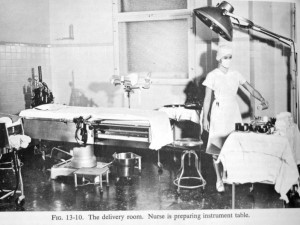A 30-day series of quotes spanning two hundred years ~ click here to begin with Day 1
You can also read the entire series as a single post
Day 4 ~ 1911 (10 entries
1911 ~ Boston Medical and Surgical Journal, 02-23-1911, page 261 {*}
… we believe it to be the duty and privilege of the obstetricians of our country to safeguard the mother and child in the dangers of childbirth.
The obstetricians are the final authority to set the standard and lead the way to safety. They alone can properly educate the medical profession, the legislators and the public.”
1911 ~ Drs. Emmons & Huntington: “Has the Trained Midwife Made Good?”
The story of obstetrical education in the country is not the story of complete success. We have made ourselves the jest of scientists throughout the world by our lack of a uniform standard. TAASPIM; 1911-C, , p. 207]
1911~ Dr J. Whitridge Williams, chief of obstetrics, Johns Hoskins, authorWilliams Obstetrics
| 8 |
[This] seem to indicate that women in labor are safer in the hands of …. midwives that in those of poorly trained medical men. Such conclusion however, is contrary to reason, as it would postulate the restriction of obstetrical practice to the former (midwives) and the abolition of medical practitioners, which would be a manifest absurdity.” [1911-B; p.180
1911 ~ Dr. Ira Wile, MD, New York City
In NYC, … death from puerperal sepsis occur more frequently in the practice of physicians than from the work of the midwives.[1911-G TAASPIM, p.246, 1911]
1911 ~ Josephine Baker, MD, Director, Midwifery Training program, NYC
 The irregular practitioner of medicine is still permitted to be an obstetrician with anexperience that is inferior to that possessed bymore than half of the midwives.
The irregular practitioner of medicine is still permitted to be an obstetrician with anexperience that is inferior to that possessed bymore than half of the midwives.
Let us be fair to the midwife, I say, and if she is below the ideal we have for her, though we have never crystallized that ideal into law, let us give her the opportunity to rise and educate herself … .” [1911-G; TAASPIM, p. 224]
That Socrates’ mother was a midwife bears testimony to the honorable nature of such a profession at a time when civilization in one of its highest forms was at its summit. [1911-G; TAASPIM, p. 232]
1911 ~ Dr. Ira S. Wile, MD, New York City:
But it is manifestly unfair to criticize the lack of an educational standard which has never been established. When nurses were of the Sairey Gamp-type, elimination was not the cure. When apprenticeship was the open sesame to the practice of medicine …elimination was not the cure. Education, training, regulation and control solved these problems, just as they will solve the **midwife problem.
[**The ‘midwife problem’ usually referred to the problems some doctors were having their efforts to get rid of midwives.]
1911 ~ Dr. Emmons, MD: “Obstetrics Care in the Congested Districts of our Large American Cities”
I should like to emphasize what may be called the negative side of the midwife. Dr. Edgar states that the teaching material in New York is taxed to the utmost. The 50,000 cases delivered by midwivesare not available for this purpose.
Might not this wealth of [obstetrical teaching] material, 50,000 cases in NY, be utilized to train physicians?” [TAASPIM – 1911-D, p 216]
1911 ~ Dr. J. Whitridge Williams, MD, Chief of Obstetrics, Johns Hopkins University Hospital
….. the ideal obstetrician is not a man-midwife, but a broad scientific man, with a surgical training, who is prepared to cope with the most serious clinical responsibilities, and at the same time is interested in extending our field of knowledge.
No longer would we hear physicians say that they cannot understand how an intelligent man can take up obstetrics, which they regard asabout as serious an occupation as a terrier dog sitting before a rat hole waiting for the rat to escape. 1911-B
1911 ~ Dr. J.W Williams, MD,
The paucity of material [i.e. teaching cases] renders it probable thatyears may elapse before certain complications of pregnancy and labor will be observed… This is to the great detriment of thestudent.
Moreover, such restriction in [obstetrical] material greatly hampers the development of the professor and his assistants by the absence of suggestive problems and his inability to subject his own ideas to the test of experience. 1911-B, p. 171
Day 5 ~ 1912 and 1913


